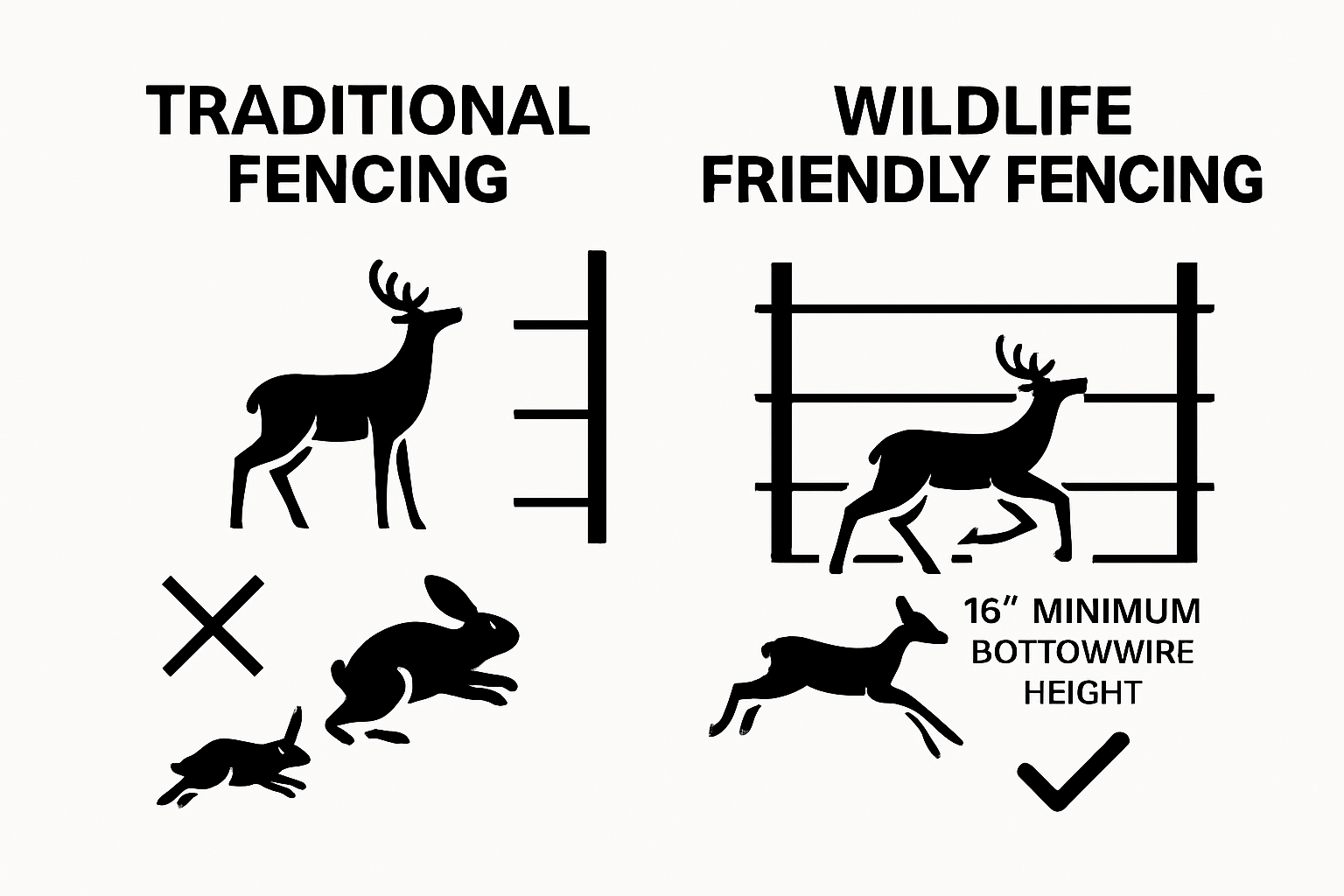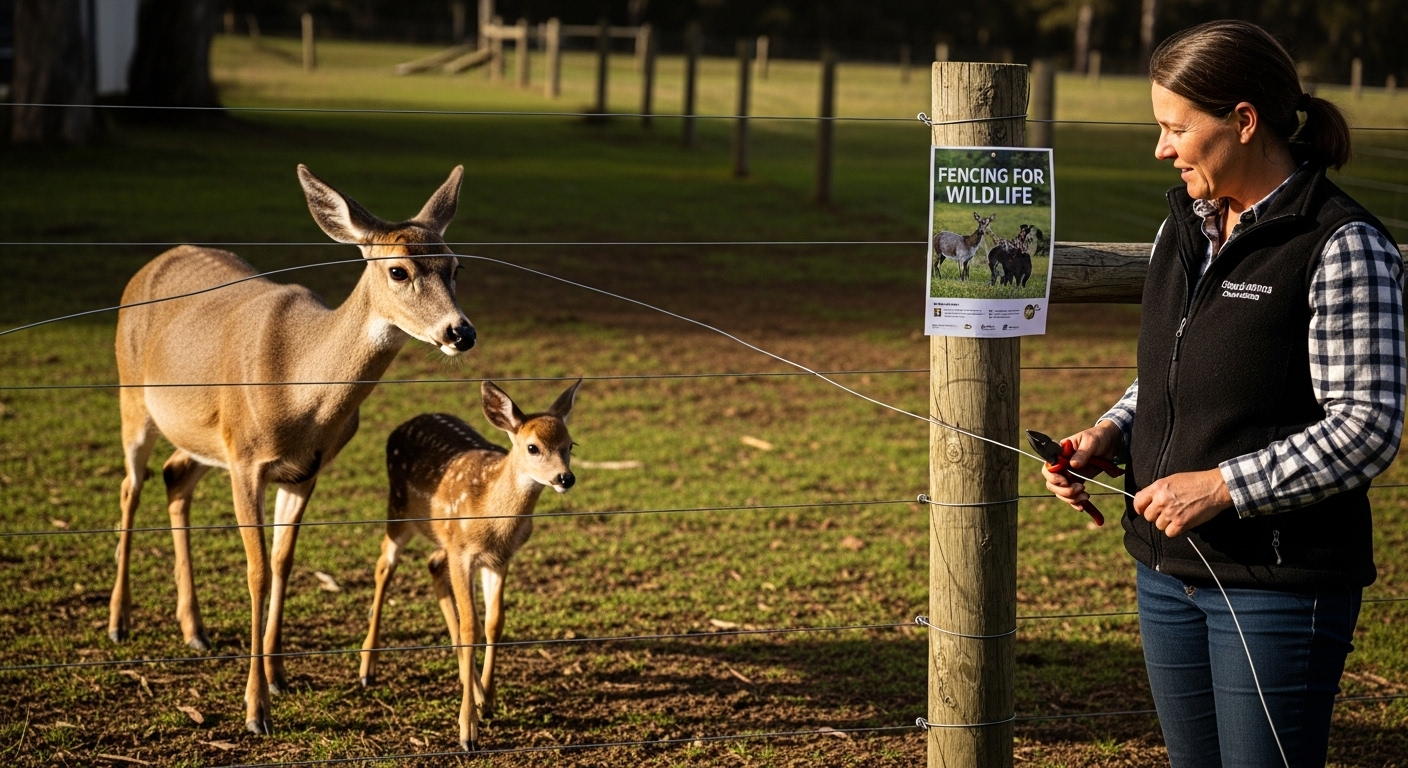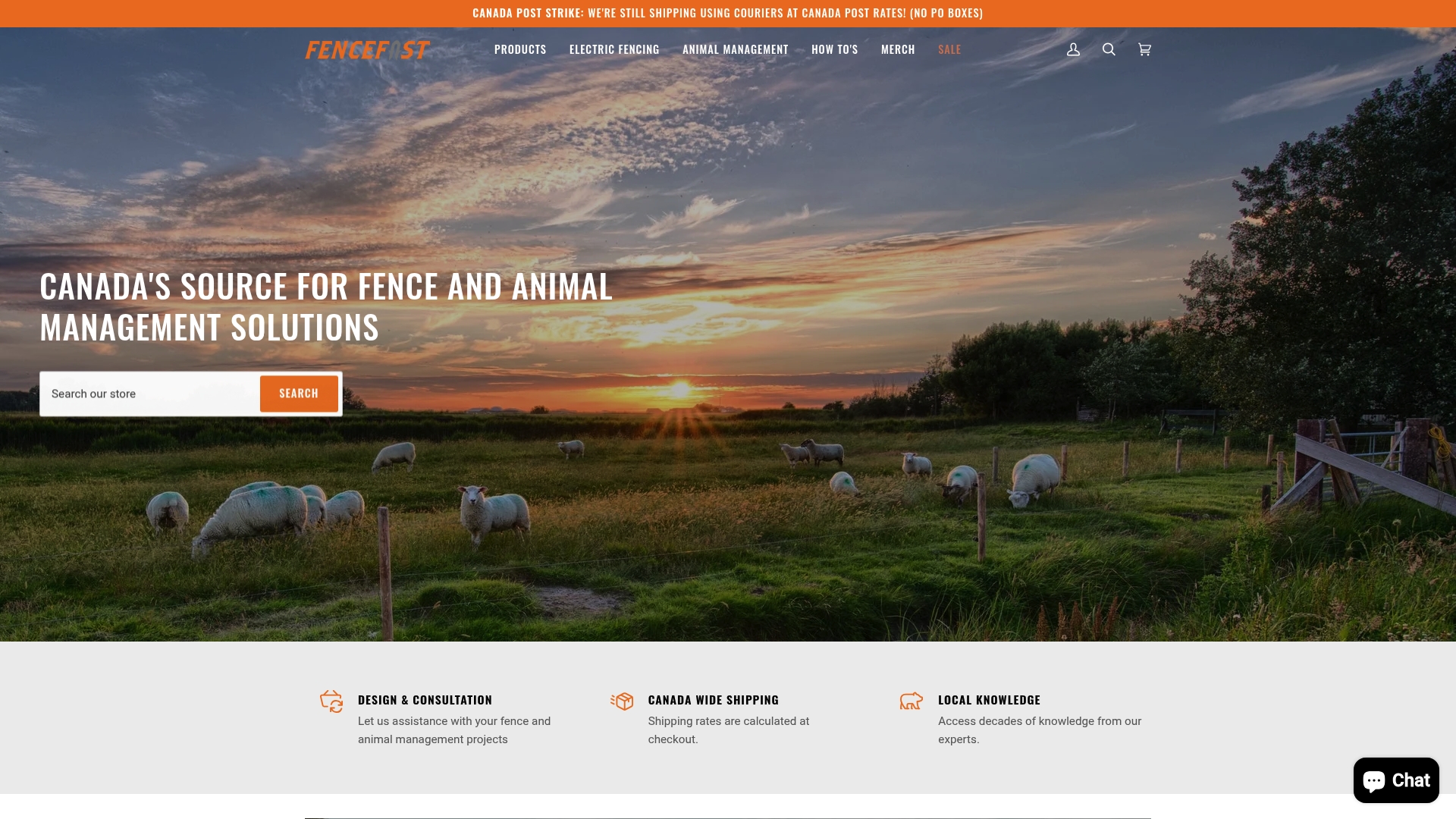Wildlife friendly fencing is changing how farms and natural habitats share the land. Traditional fences can block migration, and studies show over 1 million animals each year in North America are fatally injured by standard fencing. Most people think fences are just about keeping livestock in and predators out. The reality is that smart fence design can actually protect both farm profits and wildlife survival at the same time.
Table of Contents
- What Is Wildlife Friendly Fencing And Why Is It Important?
- The Ecological Impact Of Fencing On Wildlife
- Key Components Of Wildlife Friendly Fencing
- Real-World Benefits For Farmers And Ranchers
- Innovative Materials And Designs In Wildlife Friendly Fencing
Quick Summary
| Takeaway | Explanation |
|---|---|
| Implement wildlife friendly fencing principles | Adjust wire heights and material types to facilitate animal movement under and over fences. |
| Prioritize smooth wire over barbed wire | Smooth wire reduces injuries to wildlife, leading to safer crossings for animals. |
| Design flexible fencing systems | Use materials that can bend or break to prevent harm when animals collide with them. |
| Understand ecological impacts of fencing | Fencing affects animal migration and genetic diversity, crucial for wildlife health and survival. |
| Realize economic benefits of wildlife friendly fencing | Proper design reduces maintenance costs and potential conflicts between wildlife and livestock. |
What is Wildlife Friendly Fencing and Why is It Important?
Wildlife friendly fencing represents a strategic approach to land management that balances human agricultural needs with ecological preservation. Unlike traditional barriers that obstruct animal movement, these specialized fencing solutions allow safe passage for wildlife while maintaining property boundaries and livestock protection. Wildlife conservation experts emphasize that thoughtful fence design can significantly reduce animal injuries and habitat fragmentation.
Understanding Wildlife Barrier Challenges
Traditional fencing often creates unintended consequences for local animal populations. Sharp wire, tightly stretched cables, and high tension designs can trap, injure, or kill animals attempting to cross property lines. Large mammals like deer, elk, and antelope frequently struggle with standard fencing, which disrupts their natural migration routes and access to critical resources such as water sources and grazing lands. Read more about livestock fencing options that can help mitigate these challenges.
Key Design Principles for Wildlife Friendly Fencing
Effective wildlife friendly fencing incorporates several crucial design elements:
- Bottom Wire Height: Raising the lowest wire to at least 16 inches allows smaller animals to pass underneath safely
- Top Wire Spacing: Maintaining 12 to 18 inches between top wires prevents large animals from becoming entangled
- Smooth Wire Selection: Using smooth wire instead of barbed wire reduces potential injury risks
- Flexible Materials: Selecting materials that can bend or break under animal pressure minimizes potential harm
By implementing these design principles, landowners can create functional barriers that protect agricultural interests while simultaneously supporting local wildlife ecosystems.
The goal is not elimination of fencing, but rather smarter, more considerate infrastructure that recognizes the interconnected nature of human and animal habitats.

The Ecological Impact of Fencing on Wildlife
Fencing represents more than just physical infrastructure across landscapes - it functions as a critical ecological intervention that dramatically influences wildlife movement, habitat connectivity, and species survival. Scientific research demonstrates that conventional fencing can create substantial barriers disrupting natural animal migration patterns and ecosystem interactions.
Habitat Fragmentation and Ecological Disruption
Wildlife requires unobstructed movement for multiple essential activities including breeding, foraging, and seasonal migration. Traditional fencing interrupts these natural corridors, effectively creating invisible walls that compartmentalize animal territories. These barriers prevent genetic exchange between populations, restrict access to critical resources like water and food sources, and increase mortality risks for numerous species. Check our guide on small farm fencing to understand more nuanced approaches.
Quantifiable Wildlife Consequences
The ecological consequences of inappropriate fencing are significant and measurable across multiple dimensions:
- Population Genetic Diversity: Restricted movement reduces genetic mixing, potentially leading to inbreeding and reduced species resilience
- Migration Patterns: Fencing can interrupt critical seasonal migration routes for mammals and birds
- Predator Interaction: Unintended fence designs can create hunting advantages for predators or trapping scenarios for prey
- Resource Access: Blocking natural pathways limits animals’ ability to reach water, breeding grounds, and seasonal food sources
Understanding these complex interactions requires recognizing fencing not just as a physical boundary, but as a dynamic ecological interface that profoundly influences wildlife survival and ecosystem health.
This table compares traditional fencing to wildlife friendly fencing across several key ecological and operational dimensions to illustrate their impact on both wildlife and farm management.
| Aspect | Traditional Fencing | Wildlife Friendly Fencing |
|---|---|---|
| Wildlife Movement | Frequently obstructs migration and daily movement | Facilitates movement over and under fences |
| Animal Safety | Can trap, injure, or fatally harm animals | Designed to minimize injury and entanglement |
| Habitat Connectivity | Causes fragmentation and blocks resource access | Supports genetic diversity and ecosystem health |
| Maintenance Requirements | Higher due to animal damage and breakage | Lower, as flexible designs reduce animal-related damage |
| Economic Impact | Can incur higher costs from repairs and lost livestock | Reduces conflicts, stress, and maintenance expenses |
| Thoughtful, strategically designed wildlife friendly fencing can transform these barriers from obstacles into permeable membranes that balance human land use needs with natural animal movement requirements. |
Key Components of Wildlife Friendly Fencing
Wildlife friendly fencing goes beyond standard infrastructure, integrating specialized design principles that prioritize animal safety and ecosystem connectivity. Wildlife management experts emphasize precise technical specifications that transform traditional barriers into permeable, animal-compatible boundaries. Explore our poultry fencing guide to understand specialized fencing approaches.
Wire Configuration and Material Selection
The fundamental components of wildlife friendly fencing revolve around strategic wire placement and material choices. Smooth wire is crucial, replacing barbed alternatives that can cause severe animal injuries. Horizontal wire spacing becomes a critical design element, with recommended distances that allow safe animal passage while maintaining functional property boundaries. The lowest wire should be positioned sufficiently high to permit smaller animals to move underneath, typically 16 to 18 inches from ground level.
Essential Design Parameters
Comprehensive wildlife friendly fencing incorporates multiple design considerations:
- Smooth Wire Preference: Eliminates sharp edges that could entangle or injure wildlife
- Flexible Material Selection: Allows partial give under animal pressure, reducing potential harm
- Strategic Wire Spacing: Creates intentional gaps for animal movement
- Ground Clearance: Ensures unobstructed passage for smaller ground-dwelling species
These design principles recognize fencing not as a rigid barrier, but as a dynamic interface between human land use and wildlife habitat. By thoughtfully engineering fence structures that accommodate natural animal movement, landowners can simultaneously protect agricultural interests and support local ecosystem health.
Below is a table summarizing the essential design parameters for wildlife friendly fencing, highlighting each feature and the benefit it provides for both animals and landowners.
| Design Parameter | Explanation | Benefit |
|---|---|---|
| Bottom Wire Height | Raised to at least 16 inches for safe passage | Allows smaller animals to move underneath fences |
| Top Wire Spacing | 12 to 18 inches between top wires | Prevents entanglement of large animals |
| Smooth Wire Selection | Uses smooth, not barbed, wire | Reduces injury risks to wildlife crossing the fence |
| Flexible Materials | Materials that bend or break under pressure | Minimizes harm if animals collide with the fence |
| Strategic Wire Spacing | Deliberate gaps for animal movement | Maintains barrier function while supporting migration |
| Ground Clearance | Clearance for ground-dwelling species | Ensures unobstructed passage for small wildlife |
Real-World Benefits for Farmers and Ranchers
Wildlife friendly fencing represents more than an ecological strategy - it offers tangible economic and operational advantages for agricultural professionals. Sustainable farming research demonstrates that adaptive land management practices can simultaneously protect livestock, preserve natural habitats, and optimize agricultural productivity.
Economic and Operational Advantages
Contrary to conventional beliefs, wildlife friendly fencing does not compromise agricultural efficiency. These specialized designs reduce long-term maintenance costs by minimizing animal-related infrastructure damage. Livestock remain protected while creating corridors that allow wildlife safe passage, reducing potential conflicts and property destruction. Strategic fence designs can prevent costly wildlife interactions such as animal entanglement, unexpected livestock injuries, and unintended property breaches.
Conservation and Agricultural Synergy
Farmers and ranchers implementing wildlife friendly fencing practices unlock multiple strategic benefits:
- Reduced Livestock Stress: Minimized wildlife confrontations create calmer grazing environments
- Lower Maintenance Expenses: Durable, flexible fence designs require less frequent repairs
- Potential Tax Incentives: Some regions offer conservation-oriented agricultural subsidies
- Enhanced Property Resilience: Ecosystem-compatible infrastructure supports long-term land health
These approaches transform agricultural boundaries from rigid barriers into dynamic, responsive systems that recognize the interconnected nature of farming, wildlife, and sustainable land management. By adopting wildlife friendly fencing, agricultural professionals become active participants in broader ecological conservation efforts while protecting their economic interests.
Innovative Materials and Designs in Wildlife Friendly Fencing
Advanced fencing technologies are revolutionizing how agricultural professionals approach wildlife interaction and land management. Livestock fencing experts recognize that material innovation plays a critical role in creating permeable, adaptive boundary systems that balance ecological preservation with practical agricultural needs.
Emerging Material Technologies
Modern wildlife friendly fencing leverages cutting-edge materials designed to provide flexibility, durability, and animal safety. Composite polymers, high-tension synthetic fibers, and smart wire technologies enable fence designs that can absorb animal pressure without causing injury. These advanced materials allow for fence structures that can bend, stretch, and recover, creating dynamic barriers that respond intelligently to wildlife movement.
Design Characteristics of Next-Generation Fencing
Innovative wildlife friendly fencing incorporates several groundbreaking design principles:
- Adaptive Tension Mechanisms: Materials that automatically adjust tension to prevent animal entrapment
- Self-Healing Polymers: Synthetic materials that can recover from minor damage or stress
- Integrated Visibility Markers: Enhanced visual signals that help animals recognize and navigate fence boundaries
- Modular Configuration Options: Fence designs that can be easily reconfigured to accommodate changing ecological conditions
These technological advancements represent more than incremental improvements. They signify a fundamental reimagining of fencing as a responsive, intelligent interface between agricultural infrastructure and natural ecosystems. By embracing these innovative approaches, landowners can create boundary systems that protect both human interests and wildlife habitats.

Ready to Make Your Land Truly Wildlife Friendly?
If you are working hard to manage your land sustainably, you already know how challenging it is to balance livestock needs with the wellbeing of local wildlife. Traditional fencing can lead to entanglements, blocked migration routes, and costly repairs—all issues tackled in wildlife friendly fencing. At FenceFast.ca, we specialize in innovative fencing and animal management supplies that make it easy to upgrade your property with smart, animal-safe solutions. Our products are designed to reduce stress for your livestock and protect local ecosystems, providing the tools you need for a more sustainable and efficient operation.

Take the next step toward a more resilient and wildlife conscious farm today. Explore our full range of fencing components, electric systems, and expert advice by visiting FenceFast.ca. Discover tips on livestock fencing options and learn more about selecting the right fencing for small farms. The sooner you act, the sooner you protect both your animals and the natural world around you.
Frequently Asked Questions
What is wildlife friendly fencing?
Wildlife friendly fencing is a type of fencing designed to protect agricultural land while allowing safe passage for wildlife. It incorporates specific design principles that reduce harm to animals and minimize habitat fragmentation.
How does wildlife friendly fencing benefit farmers and ranchers?
Wildlife friendly fencing offers economic and operational advantages such as reduced livestock stress, lower maintenance costs, and potential tax incentives, while supporting local ecosystems and wildlife movement.
What are the key design features of wildlife friendly fencing?
Key design features include raising the bottom wire to at least 16 inches for smaller animals, maintaining smooth wire to prevent injuries, and using flexible materials that bend under pressure to minimize harm.
How does traditional fencing negatively impact wildlife?
Traditional fencing can trap, injure, or kill wildlife, disrupt migration routes, prevent access to essential resources, and lead to decreased genetic diversity among animal populations due to restricted movement.
